Weiser Collection and More at Pook & Pook
January 12th, 2013
|
Fern Isabel Coppedge (1883-1951), oil on canvas, Autumn From Music Circus Hill, Lambertville, signed lower right, 25" x 30½", sold for $65,175 (est. $20,000/40,000).
Berks County, Pennsylvania, pine hanging corner cupboard, circa 1790, with a double-raised-panel door and scalloped two-tier drop, is inscribed on the inside of the door “From Eshelman family, Oley Valley, PA.” It is 55½" high x 27½" wide. It sold at Sotheby’s in January 1997 for $39,100. Sixteen years later with a David Wheatcroft provenance, it sold on the phone for $52,140 (est. $10,000/20,000) with competition from an absentee bidder and from Philip Bradley in the salesroom.
Southeast Pennsylvania redware covered bowl, circa 1800, with extensive slip star and tulip decoration, 5" high x 8½" diameter, sold to an absentee bidder for $5214 (est. $500/1000). At Sotheby’s Helen Janssen Wetzel sale in October 1980, it was given a full-page color illustration, and it sold for $4400 (est. $1500/2500).
Oversize Pennsylvania wrought-iron spatula with elaborate inlaid brass decoration and the initials and date “IB 1826,” 21" high. The size and proportion of this piece suggest it may have been made as a wedding gift. It sold for $5346 to an on-line bidder (est. $1500/2500).
Pennsylvania painted tape loom, dated 1826, possibly western Pennsylvania, initialed “NL,” with heart cutouts and lovebird decorations on a red ground with a yellow border, 15" high x 13¾" wide x 6¾" deep. In 1998 Pastor Frederick S. Weiser bought it from Greg Kramer, who found it in western Pennsylvania. Dealer Steven Still of Manheim, Pennsylvania, bought it for $9480 (est. $2000/4000).
Pair of Pennsylvania wrought-iron strap hinges, circa 1800, with tulip terminals, 24¾" long, from the Weiser estate, sold on the phone for $5214 (est. $800/1200).
Pennsylvania cast-iron five-plate stove, made by George Ross at the Mary Ann Furnace in York County, Pennsylvania, dated 1766, decorated with hearts and tulips, 24" high x 19½" wide x 24½" deep, came from the estate of Frederick Weiser. Complete five-plate stoves are very rare; see Henry Chapman Mercer’s The Bible in Iron. Provenance includes Robert Martin of Hanover, Pennsylvania. The stove was found disassembled in a house near Spring Grove, Pennsylvania. It sold to dealer Philip Bradley for $33,180 (est. $4000/6000). Bradley said there is one like it at Winterthur.
Four 19th-century Birmingham silver nutmeg graters from the collection of Mr. and Mrs. Guy Keemer of Hallam, Pennsylvania, sold on line for $4131 (est. $300/500). |
Pook & Pook, Downingtown, Pennsylvania
Photos courtesy Pook & Pook
If the old Wall Street aphorism “As January goes, so goes the year” can be applied to the January Americana sales, then Pook & Pook’s January 12 sale may indicate that there will be an uptick in the Americana market this year. The sale, however, was a regional one; the market it measured was mainly Pennsylvania material. Of the 502 lots offered, 480 sold (95.6%) for a total of $1,660,782 (with buyers’ premiums). The presale estimate was $857,500/1,437,400 figured without buyer’s premium, and the total without the premium was near the top at $1,398,750.
The sale opened with 55 lots from the estate of Frederick S. Weiser (1935-2009) of New Oxford, Pennsylvania, who was one of the most often consulted authorities on Pennsylvania German culture. Weiser was the pastor of St. Paul Lutheran Church, Biglerville, Adams County, Pennsylvania. He also taught at Gettysburg College and was an archivist at the Lutheran Theological Seminary in Gettysburg. He lectured and wrote widely, was editor for the Pennsylvania German Society from 1966 to 1982, and was a translator and cataloger of collections of fraktur including the collections at Winterthur and at the Free Library of Philadelphia.
In addition to his scholarly pursuits and a long list of publications, Weiser lived with Pennsylvania German household gear. His collection of fraktur and some textiles were acquired by Winterthur (see M.A.D., January 2013, p. 9-A). Among the 55 lots auctioned at Pook & Pook were things you might never find again. They brought much more than Ron Pook thought they would.
A painted tape loom sold for twice the high estimate to dealer Steven Still of Manheim, Pennsylvania, who had sold some of the things to Weiser and was a major buyer at this portion of the sale. The tape loom cost him $9480 (est. $2000/4000). A hatchel used for breaking down flax for making yarn with a painted cover with the date 1804 and the initials “HS” sold well over the estimate for $4266 (est. $400/600) to dealer Philip Bradley of Downingtown, Pennsylvania. The same price was paid for a small wrought-iron dough scraper pierced with two fat hearts (est. $1000/2000). In 1945 Hattie Brunner sold it to Titus Geesey, and in 2002 it went to Steven Still. A pair of Pennsylvania wrought-iron hinges with tulip terminals and sunbursts mid-strap sold for $5214 (est. $800/1200). A bit more than that, $5346, more than twice the high estimate, was paid for an oversize wrought-iron spatula with brass inlaid initials “IB” and the date 1826. Six butter prints went for $3555 (est. $400/700). A five-plate stove made by George Ross at the Mary Ann Furnace in York County, Pennsylvania, dated 1766, sold to Bradley for $33,180, more than five times the $6000 high estimate. Bradley was the underbidder for Weiser’s Berks County pine hanging corner cupboard that sold on the phone for $52,140 (est. $10,000/20,000). The ultimate beneficiary of the Weiser estate is Gettysburg College, Weiser’s alma mater.
“Wow!” said Ron Pook when he relinquished the gavel to Jamie Shearer after he had finished auctioning the collection of Mr. and Mrs. Guy Keemer of Hallam, Pennsylvania. Guy Keemer was a regular at Pook & Pook auctions, and Ron Pook was glad to see his Pennsylvania material do well. Unfortunately Guy Keemer died just a few weeks before the sale. His walnut pewter cupboard sold for $8888 (est. $3000/5000) to dealer James Price of Carlisle, Pennsylvania. His diminutive red-painted walnut hanging cupboard went to Bradley for $35,550 (est. $15,000/25,000), and Bradley also bought Keemer’s architectural schrank for $65,175 (est. $20,000/40,000). Keemer had paid $3200 to Vernon Gunnion for it in 1973. Gunnion was the underbidder.
Quilts from the collection of Foster and Muriel McCarl also performed well. A Philadelphia broderie perse quilt, pictured on the back cover of the catalog, is inscribed “The work of my Mother Ruth McConnell & her cousins Hannah & Mary Parry in year 1793 previous to my birth (September of that year) during yellow fever-Julia M. Miles May 14th 1849.” It has a large central basket with floral vines surrounded by smaller bouquets and two corner cornucopias filled with flowers and a swag pattern chintz border. It sold on the phone for $28,440 (est. $8000/12,000). The same price, more than twice its $10,000 high estimate, was paid for a mid-19th-century Baltimore album quilt, with 25 appliqué and trapunto squares depicting the U.S. Capitol, an American sailing ship, a house, a monument with American flags, elaborate baskets of flowers, cornucopias, and garlands. There was a similarity in the appliqués and the border with the Baltimore album quilt that sold at the M. Austin and Jill R. Fine sale at Sotheby’s in January 1987 for $176,000.
Two pieces of furniture from the McCarl collection sold for far less than the McCarls paid for them. The Hussey family Massachusetts Chippendale carved and figured mahogany desk-and-bookcase, circa 1770, probably Newbury- port, Massachusetts, retaining its original finial and cast brass hardware, sold on the phone for $37,920 (est. $25,000/45,000). At Sotheby’s Robert E. Crawford sale in October 2001 it sold for $203,750 (est. $100,000/$150,000). The McCarls’ Lancaster, Pennsylvania,
walnut desk-and-bookcase that failed to sell at Sotheby’s in September 2012 when it was offered with a $50,000/100,000 estimate sold on the phone for $45,030 (est. $15,000/ 25,000).
The highlight of the various-owners’ portion of the sale was a silver-mounted presentation sword with a double-edged blade and double eagle-headed crossguard that is engraved “Presented to Lieutenant James Biddle U.S.N. by the legislature of Pennsylvania, Dec. 1812.” It sold for $56,880 (est. $5000/10,000) to dealer James Kochan of Frederick, Maryland, underbid on the phone. A group from Andalusia, the Classical Revival house that Nicholas Biddle built on the Delaware River, had hoped to buy it but dropped out of the bidding at $35,000. Kochan said he would lend the sword to Andalusia for a short time or for a special occasion, but he bought it to keep. Kochan paid $5925 (est. $4000/8000) for another early silver-mounted eagle- head saber, 1800-10, with a silver-mounted leather scabbard. He said he thought it might have been made by Philadelphia silversmith Thomas Fletcher.
The feel-good story from this sale was the return of Jacob A. Light’s monumental “National Clock,” dated 1908, to Millersburg, Pennsylvania. This room-size clock with a mechanical panorama of 19 scenes and 380 figures including a parade of U.S. presidents from Washington through Coolidge, Civil War generals, Uncle Sam, and depictions of the Last Supper, the Crucifixion, and heaven and hell, is a major piece of visionary art. It was consigned by a Pennsylvania collector who had paid $85,000 for it, and Pook hoped to get $20,000/40,000 for it. Pook said he was thrilled that the Millersburg Historical Society’s bid of $14,000 won it. The society paid $16,590 with the buyer’s premium. John Carpenter, a member of the historical society who did the bidding, said the town wanted it so badly they had raised four times as much. It will be a responsibility to care for it and keep it dust free and working. Among the members of the historical society who attended the sale were the maker’s great-grandson Warner Jarnagin and his mother, the granddaughter-in-law of the maker. They said they were looking forward to bringing this treasure home. It will be well worth a trip to Millersburg, 30 miles north of Harrisburg, to see this clock in action. That consignor made up for the low bid on this lot with other lots in the sale. His outside row carousel white tiger sold for $33,180 (est. $3000/5000), and he owned the James Biddle presentation sword that went for $56,880 (est. $5000/10,000). His painting by John George Brown of a young girl in a landscape sold for $52,140 (est. $15,000/25,000).
The pictures and captions tell more. For more information, visit (www.pookandpook.com) or call (610) 269-4040. Pook & Pook’s next catalog sale is scheduled for April 19 and 20.

The Hussey family Massachusetts Chippendale carved and figured mahogany desk-and-bookcase, circa 1770, probably Newburyport, retaining its original finial and cast brass hardware, 92" high x 40" wide x 22½" deep, sold on the phone for $37,920 (est. $25,000/45,000). Owned by Silvanus Hussey Jr. of Nantucket, Massachusetts, it descended through the Hussey family until sold. From a private Richmond, Virginia, collection, it sold at Skinner in January 1991 for $33,000. In 2001 it sold at Sotheby’s Robert E. Crawford collection sale for $203,750 (est. $100,000/150,000). |

Outside row standing carousel tiger, circa 1910, probably from the workshop of Daniel Muller, 52½" high x 59" wide, sold on the phone for $33,180 (est. $3000/5000), underbid by a collector in the salesroom. |
|
|
|
|
|
|
|
|
Originally published in the March 2013 issue of Maine Antique Digest. © 2013 Maine Antique Digest


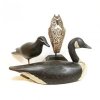







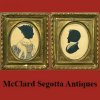

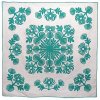



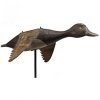



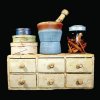

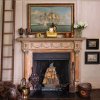







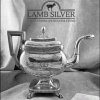

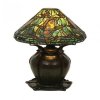









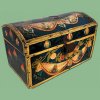










 Philadelphia broderie perse quilt, inscribed “The work of my Mother Ruth McConnell & her cousins Hannah & Mary Parry in year 1793 previous to my birth (September of that year) during yellow fever-Julia M. Miles May 14th 1849,” with a large central basket filled with floral vines surrounded by smaller bouquets and cornucopias, all within a chintz border. In a remarkable state of preservation for a quilt of its age, it sold on the phone for $28,440 (est. $8000/12,000).
Philadelphia broderie perse quilt, inscribed “The work of my Mother Ruth McConnell & her cousins Hannah & Mary Parry in year 1793 previous to my birth (September of that year) during yellow fever-Julia M. Miles May 14th 1849,” with a large central basket filled with floral vines surrounded by smaller bouquets and cornucopias, all within a chintz border. In a remarkable state of preservation for a quilt of its age, it sold on the phone for $28,440 (est. $8000/12,000). Appliqué Cockscomb variant quilt, late 19th century, 71" x 73", sold for $1304 (est. $400/700) to dealer Richard Worth of Chadds Ford, Pennsylvania, in the salesroom.
Appliqué Cockscomb variant quilt, late 19th century, 71" x 73", sold for $1304 (est. $400/700) to dealer Richard Worth of Chadds Ford, Pennsylvania, in the salesroom. William Otto (active 1834-40), watercolor and ink on paper birth record with two women in striped dresses and colorful birds on floral branches flanking a center heart-shaped cartouche, enclosing script for the son of William Otto and his wife, Agatha, signed middle center “William Otto 1837,” 12½" x 16". William Otto was the son of fraktur artist Heinrich Otto. The birth record sold on line for $20,655 (est. $5000/10,000). A similar example sold at Sotheby’s sale of the Deyerle collection in May 1995 for $21,850. The one at Pook & Pook had a David Wheatcroft provenance.
William Otto (active 1834-40), watercolor and ink on paper birth record with two women in striped dresses and colorful birds on floral branches flanking a center heart-shaped cartouche, enclosing script for the son of William Otto and his wife, Agatha, signed middle center “William Otto 1837,” 12½" x 16". William Otto was the son of fraktur artist Heinrich Otto. The birth record sold on line for $20,655 (est. $5000/10,000). A similar example sold at Sotheby’s sale of the Deyerle collection in May 1995 for $21,850. The one at Pook & Pook had a David Wheatcroft provenance. Logan family pair of Philadelphia Chippendale mahogany ribbon-back dining chairs, late 18th century, made by Thomas Tufft for Stenton in 1783. They are originally part of a set of 12. Another chair from this set is illustrated in Hornor’s Blue Book: Philadelphia Furniture, plate 289. They sold for $21,330 (est. $3000/5000). The buyer was Virginia Whalen bidding for the National Society of the Colonial Dames of America in the Commonwealth of Pennsylvania for Stenton. The underbidder was a collector.
Logan family pair of Philadelphia Chippendale mahogany ribbon-back dining chairs, late 18th century, made by Thomas Tufft for Stenton in 1783. They are originally part of a set of 12. Another chair from this set is illustrated in Hornor’s Blue Book: Philadelphia Furniture, plate 289. They sold for $21,330 (est. $3000/5000). The buyer was Virginia Whalen bidding for the National Society of the Colonial Dames of America in the Commonwealth of Pennsylvania for Stenton. The underbidder was a collector.








